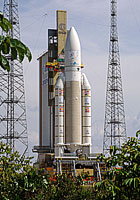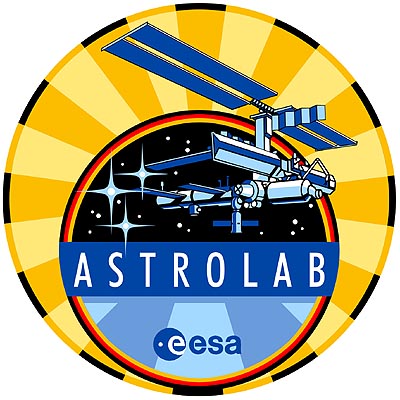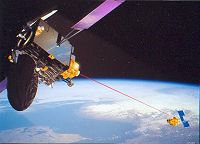   |
| HOME | ASI | ESA | NASA | ROSAVIAKOSMOS | SATELLITI E SONDE | PROPULSIONE |
| SPACE /// | LE GALASSIE | LE STELLE | IL SISTEMA SOLARE | PIANETI INTERNI | PIANETI ESTERNI |
.png) AGENZIA SPAZIALE EUROPEA Ufficialmente l'ESA viene costituita il 30 maggio 1975 L’organizzazione comprende i seguenti paesi : FRANCIA, GERMANIA, ITALIA,GRAN BRETAGNA, SPAGNA, BELGIO, DANIMARCA, OLANDA, SVEZIA, SVIZZERA, GRECIA, AUSTRIA, NORVEGIA, FINLANDIA, PORTOGALLO, AUSTRIA, IRLANDA, LUSSEMBURGO.
STRUTTURA DELL’ESA QUARTIER GENERALE Collocato a Parigi , comprende l’ufficio del direttore generale , tutti i vari direttorati dei progetti in corso e dei centri - laboratori sparsi in Europa e nel mondo, nonché le varie amministrazioni generali. Il CONSIGLIO è costituito dai rappresentanti degli stati membri designati dai rispettivi ministeri competenti per lo spazio. UFFICI ESA BRUXELLES , MOSCA , WASHINTON , HOUSTON , GUYANA FRANCESE CENTRI ESOC – European space operation centre. Damstadt ( Germania ) Controllo e monitoraggio di tutti i satelliti e sonde che l’Esa ha in orbita. ESTEC – European space resarch and thechnology centre NoordwjkOlanda 1) laboratori di meccanica e ricerche termiche 2) laboratori sui materiali e la microgravità 3) laboratori di telecomunicazione 4) laboratorio di robotica ESRIN – European space reserch institute. Frascati (RM) Italia In maniera organica viene effettuata una raccolta,catalogazione e distribuzione a tutti i stati membri, dei dati raccolti dalle sonde e satelliti dell’Esa. Vengono curate le pubbliche relazioni EAC – European astronaut centre. Colonia (Germania) Centro addestramento corpo spaziale europeo. ESAC - European Space Astronomy Centre a Villafranca Del Castillo, vicino Madrid Spagna. Centro operativo scientifico per le missioni di tipo astronomico. |
|
| PROPULSORI ESA |
| |
| | ORIGINI Alla fine degli anni 50 ci fu la consapevolezza della necessità di un’agenzia spaziale europea, ricordiamo tra i principali sostenitori il francese Pierre Auger e l'italiano Edoardo Amaldi. Nel 1960 fu formato il primo gruppoGEERS (Groupe d’Etude Europeen Recherches Spatiales), al quale seguirono altri gruppi. Nel 1964 si individuarono la ELDO (European Launch Development Organisation) per sviluppare sistemi di lancio e la ESRO ( European Space Research Organisation) per sviluppare i veicoli spaziali (Spacecraft) come satelliti, sonde e altro. Nel 1975 si decise di fondare l’ESA che avrebbe raggruppato in se tutte le organizzazioni. Nel 1980 si forma l’Arianespace (Francia) col compito di sviluppare il progetto del vettore europeo Ariane. L’ESA ha portato avanti numerosi progetti in collaborazione con le altre agenzie spaziali, in particolare con la NASA. Il 1979 il primo lancio Ariane 1 (fig.sinistra). Nel 1986 il lancio dela sondaGiotto per lo studio delle comete Halley e Grigg (fig.destra) |
| LISTA DELLE PRINCIPALI MISSIONI DELL'ESA SINO AL 2010 |
|
CryoSat (Foto credit ESA) | EARTH OBSERVATION Meteosat-1 1977 Pre-operational meteorological services/ Meteosat-2 1981 Pre-operational meteorological services/ Meteosat-3 1988 Pre-operational meteorological services/ Meteosat-4 1989 Operational meteorology/ Meteosat-5 1991 Operational meteorology /ERS-1 1991 Pre-operational Earth observation radar /Meteosat-6 1993 Operational meteorology /ERS-2 1995 Pre-operational Earth observation radar /Meteosat-7 1997 Operational meteorology /Proba-1 2001 Technology/Earth observation /Envisat 2002 Earth observation /Meteosat-8 2002 Formerly MSG-1, operational meteorology /MSG-2 2005 Operational meteorology /MetOp-A 2006 Meteorological services /GOCE 2009 Gravity field and geoid /SMOS 2009 Soil moisture and ocean salinity /CryoSat-2 2009 Ice sheets and marine ice cover /Swarm 2010 Magnetic field studies /Aeolus 2011 Atmospheric dynamics /Sentinel-12011 Operational radar imaging /MSG-3 2011 Operational meteorology /MetOp-B 2012 Polar meteorology /Sentinel-2 2012 Land monitoring /Sentinel-3 2012 Marine monitoring /EarthCARE 2013 Radiation and cloud interactions /MSG-4 2013 Operational meteorology /MTG-1 2015 Meteosat Third Generation /MetOp-C 2016 Polar meteorological services /Sentinel 4 2017 Payload for atmospheric monitoring /Sentinel 5 2020 Payload for atmospheric |
| SUN | SUN and SOLAR SYSTEM ESRO-2 1968 Cosmic and X-radiation from the Sun /ISEE-B 1977 International Sun-Earth Explorer /Ulysses 1990 First spacecraft to overfly the Sun’s poles /SOHO 1995 Studying the Sun’s core, outer corona and solar wind /Cluster & Double 2000 Interaction of the solar wind and Earth’s /Star (with China) 2003/4 magnetosphere /Solar Orbiter 2017 Study of the Sun from close range Aurora 1968 Polar frontiers of the Van Allen radiation belt /HEOS-1 1968 Interplanetary magnetic fields /Boreas1969 Polar frontiers of the Van Allen radiation belt /HEOS-2 1972 Interplanetary magnetic field /ESRO-4 1972 Upper atmosphere temperature variations /GEOS-1 1977 Plasma particles and waves in Earth’s magnetic field /GEOS-2 1978 Movement in Earth’s upper atmosphere /Giotto 1985 Fly-past of Comet Halley and Comet Grigg-Skjellerup /Cassini-Huygens 1997 Exploring Saturn’s system and descending onto its largest moon Titan /Mars Express 2003 Studying the atmosphere, surface and subsurface of the Red Planet /SMART-1 2003 Testing solar-electric propulsion and studying the Moon’s surface /Huygens 2004 Probing the atmosphere and surface of Titan /Rosetta 2004 Orbiter of Comet 67P/Churyumov- Gerasimenko and Philae lander /Venus Express 2005 Exploring Venus and its atmosphere /BepiColombo 2014 Exploring the planet Mercury |
|
Arthemis | ASTRONOMY TD-1A 1972 Measuring ultraviolet radiation from 15000 stars /Cos-B 1975 Gamma-ray studies /IUE 1978 Ultraviolet observations of 10 000 celestial objects /Exosat 1983 X-ray emissions of astronomical phenomena /Hipparcos 1989 Position measurements of 120 000 stars /Hubble Space 1990 Orbiting astronomical observatory Telescope /ISO1995 Exploring the infrared Universe /XMM-Newton 1999 The most sensitive X-ray observatory ever /Integral 2002 Observing the most energetic phenomena in gamma rays /Herschel 2009 Infrared emissions from stars and galaxies /Planck 2009 Studying the Cosmic Microwave Background radiation /LISA Pathfinder 2011 Technology test for LISA mission (launch 2017) /Gaia 2011 Precision mapping of one billion stars /JWST 2013 Second-generation space telescope ESA TELECOMMUNICATIONS OTS-2 12 1978 Demonstrating European telecoms technologies /Marecs-A 1981 Maritime communications /ECS-11983 Operational communications satellite /ECS-2 1984 Operational communications satellite /Marecs-B2 1984 Maritime communications /ECS-4 1987 Operational communications satellite /ECS-5 1988 Operational communications satellite /Olympus 1989 Telecoms technology demonstration /Artemis 2001 Telecommunications demonstration /AlphaSat 2011 Next-generation telecoms satellite /SmallGEO 2011‒12 Geostationary telecoms./Esa Navigation System (30 satellites) : GALILEO - Giove-A 2005, Giove-B 2008, Giove-A2 2010 |
| HOME | ASI | ESA | NASA | ROSAVIAKOSMOS | SATELLITI E SONDE | PROPULSIONE |
| SPACE /// | LE GALASSIE | LE STELLE | IL SISTEMA SOLARE | PIANETI INTERNI | PIANETI ESTERNI |







